Showing 457–468 of 2561 resultsSorted by popularity
-
Sale!
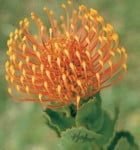
Carnival Coast Leucospermum (pincushion) 15cm Pot
Original price was: R195.00.R139.99Current price is: R139.99.Add to cartCarnival Coast Leucospermum (pincushion) 15cm Pot
Full Sun
Waterwise
Drought tolerant
Low Watering
Wind Tolerant -

Zamioculcas Zamiifolia 14cm Pot (ZZ Plant)
R275.00Add to cartZamioculcas Zamiifolia 14cm
Common Name: ZZ PlantThe ZZ plant is an easy to grow and care for indoor plant that displays small glossy leaves on stems which can grow up to 1.2m long indoors.
-

-
Sale!

Ayoba Pink Leucospermum (pincushion) 15cm Pot
Original price was: R195.00.R139.99Current price is: R139.99.Add to cartAyoba Pink Leucospermum (pincushion) 15cm Pot
-
Sale!
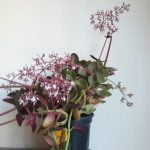
Crassula Multicava “Red Gold” 12cm Pot
All Plants, Full Sun Plants, Indigenous Plants, Semi Shade Plants, Shade Plants, Succulents, Water Wise PlantsOriginal price was: R65.00.R49.99Current price is: R49.99.Add to cartCrassula Multicava “Red Gold” 12cm Pot
Full Sun
Semi Shade
Shade
Evergreen
Low Watering -
Sale!

Ceratonia Siliqua 20lt
Original price was: R550.00.R379.99Current price is: R379.99.Add to cartCeratonia Siliqua 20lt
Common Name: Carob Tree, Locust TreeFull Sun
Semi Shade
Medium Watering
Drought Resistant
Evergreen TreeCeratonia siliqua, commonly known as the carob tree, is a flowering evergreen tree in the Fabaceae family. It is native to the Mediterranean region, including parts of Southern Europe, Northern Africa, and the Middle East.
Botanical Characteristics
Leaves: The carob tree has compound leaves with 4-10 oval leaflets that are glossy and dark green.
Flowers: The tree produces small, red-tinted flowers that are either male, female, or hermaphroditic.
Fruit: The carob tree is best known for its edible pods, which are long, brown, and leathery. These pods contain a sweet pulp and several hard seeds.Growing Conditions
Climate: Carob trees thrive in warm, dry climates typical of the Mediterranean region. They are drought-tolerant and can grow in poor soils.
Soil: While they prefer well-drained, sandy, or loamy soils, carob trees can also grow in rocky and less fertile soils.
Watering: Carob trees are highly drought-resistant once established, requiring minimal water.Uses
Culinary: The pods are often ground into carob powder, which is used as a cocoa substitute in various recipes, including baked goods, beverages, and confectionery. The seeds are used to produce locust bean gum, a common thickening agent in food products.
Animal Feed: The pods are also used as livestock feed due to their high nutritional content.
Other Uses: The wood of the carob tree is hard and can be used for carpentry, while the leaves and pods have been used in traditional medicine.Nutritional and Health Benefits
Nutrient-Rich: Carob is high in fibre, calcium, and antioxidants. It is low in fat and does not contain caffeine or theobromine, making it a suitable chocolate alternative for people sensitive to these substances.
Digestive Health: The high fibre content aids in digestion and can help regulate blood sugar levels.
Heart Health: The antioxidants in carob can contribute to cardiovascular health by reducing oxidative stress and inflammation.Carob trees are valued not only for their versatility and nutritional benefits but also for their ecological role in sustainable agriculture, especially in arid and semi-arid regions.
-

Parsley Italian Flat Leaf 6 Pack Tray
R49.99Add to cartParsley Italian Flat Leaf 6 Pack Tray
We have a new range of 6 pack vegetable and herb plants on offer.
The stock of these changes daily so we will inform you should your item be suddenly out of stock.Happy Gardening!!
-
Sale!

Spring Onion 6 Pack Tray
Original price was: R60.00.R49.99Current price is: R49.99.Add to cartSpring Onion 6 Pack Tray
Growing your own vegetables offers numerous benefits, both for your health and overall well-being. Here are some of the key advantages of cultivating your own vegetables:
1. Nutritional Value: Homegrown vegetables are incredibly fresh and packed with essential nutrients. They are harvested at their peak, ensuring optimal nutritional value. You have control over the cultivation methods, allowing you to avoid pesticides or other harmful chemicals.
2. Health and Wellness: Consuming homegrown vegetables promotes a healthier lifestyle. They are typically richer in vitamins, minerals, and antioxidants, which can boost your immune system, improve digestion, and lower the risk of chronic diseases such as heart disease and certain cancers.
3. Cost Savings: Growing your own vegetables can save you money in the long run. The initial investment in plants, soil, and tools may be modest, and the ongoing expenses are significantly lower compared to purchasing fresh produce from the market. Plus, you can grow a variety of vegetables at a fraction of the cost of buying them.
4. Taste and Flavour: Homegrown vegetables often have superior taste and flavour compared to store-bought produce. You can pick them at the peak of ripeness, allowing you to savour the true essence of each vegetable. The freshness and flavours of your homegrown vegetables can enhance your culinary experiences.
5. Environmental Sustainability: Cultivating your own vegetables promotes sustainable practices. By growing your food locally, you reduce the carbon footprint associated with long-distance transportation, packaging waste, and the use of harmful chemicals. Additionally, you can compost kitchen scraps and organic waste, minimizing landfill contributions.
6. Physical Activity and Stress Relief: Gardening is an excellent form of physical activity. It involves various tasks like digging, planting, weeding, and harvesting, which can provide exercise for your body. Engaging in gardening activities can also be therapeutic, reducing stress, anxiety, and promoting relaxation.
7. Educational and Skill Development: Growing your own vegetables offers a valuable learning experience for both children and adults. It allows you to understand the importance of sustainable agriculture, appreciate the effort involved in food production, and gain knowledge about plant biology and gardening techniques. It can also encourage a sense of responsibility and patience.
8. Food Security: Having your own vegetable garden contributes to food security. It provides you with a reliable source of fresh produce, reducing dependence on external suppliers. In times of emergencies or disruptions in the food supply chain, you can rely on the sustenance from your homegrown vegetables.
9. Aesthetics and Connection with Nature: Growing vegetables adds beauty to your surroundings. A well-maintained garden can enhance the aesthetics of your home and create a peaceful environment. It allows you to reconnect with nature, appreciate the seasons, and gain a sense of accomplishment.
Overall, growing your own vegetables offers a multitude of benefits, including improved nutrition, cost savings, environmental sustainability, physical activity, and a deeper connection with nature. It’s a rewarding endeavour that can positively impact your health, well-being, and overall quality of life.
-
Sale!

Gardenia Floribunda 20lt
All Plants, Full Sun Plants, Outdoor Plants On Sale, Semi Shade Plants, Small Plants, Trees and Larger PlantsOriginal price was: R650.00.R395.00Current price is: R395.00.Add to cartGardenia Floribunda 20lt
Full Sun
Semi Shade
Medium Watering
EvergreenGardenia floribunda, commonly known as Forest Gardenia or Wild Gardenia, is a species of flowering plant in the Rubiaceae family. It is native to various regions in Southeast Asia and the Pacific Islands. Gardenia floribunda is a small to medium-sized tree or shrub, highly valued for its fragrant and beautiful white flowers.
Appearance: Gardenia floribunda is a slow-growing evergreen shrub or small tree that can reach heights of 2 to 6m. It has a dense, compact growth habit with shiny, dark green leaves that are lanceolate or elliptical in shape.
Flowers: One of the main attractions of Gardenia floribunda is its fragrant white flowers. The flowers are usually large, trumpet-shaped, and have a waxy texture. They typically have five or six petals and emit a sweet, intense fragrance, especially in the evening. The flowers can appear throughout the year, but they are most abundant during the flowering season.
Fragrance: The strong, sweet fragrance of Gardenia floribunda flowers is highly prized and often used in perfumery and the creation of scented products.
Growth Requirements: Forest Gardenia thrives in warm, tropical or subtropical climates. It prefers well-draining, slightly acidic soil and typically grows best in full sun to partial shade. Regular watering and humidity are beneficial for its overall health and flowering performance.
Uses: Gardenia floribunda is commonly grown as an ornamental plant in gardens, parks, and landscapes. Its attractive foliage and beautifully scented flowers make it a popular choice for those who seek a sensory-rich garden experience.
Wildlife Attraction: The fragrant flowers of Gardenia floribunda attract various pollinators, including bees and butterflies, which contribute to its ecological significance.
-
Sale!
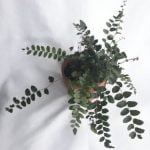
Button Fern 13cm
Original price was: R130.00.R89.99Current price is: R89.99.Add to cartPellaea Rotundifolia 13cm Pot
Common Name: Button Fern -
Sale!
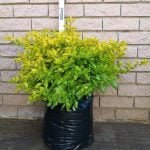
Duranta Sheenas Gold 20lt
Original price was: R550.00.R395.00Current price is: R395.00.Add to cartDuranta Sheenas Gold 20lt
Common Name: Golden DewdropFull Sun
Semi Shade
Nice for Hedging or Stand Alone
Medium Watering
Wind Tolerant
EvergreenDuranta ‘Sheena’s Gold,’ also known as Duranta erecta ‘Sheena’s Gold,’ is a cultivar of Duranta erecta, an evergreen shrub or small tree native to tropical regions of the Americas. Duranta ‘Sheena’s Gold’ is widely grown as an ornamental plant for its attractive golden foliage and its ability to add colour and texture to landscapes.
Appearance: Duranta ‘Sheena’s Gold’ is a compact, fast-growing shrub that can reach a height of 1 to 2m. It has a dense, bushy growth habit with arching branches.
Foliage: The most notable characteristic of Duranta ‘Sheena’s Gold’ is its striking golden-yellow foliage. The leaves are small, ovate to elliptical in shape, and have a bright golden-yellow colour. The vibrant foliage provides a beautiful contrast against the deep green stems and other plants in the landscape.
Flowers: Like other Duranta varieties, ‘Sheena’s Gold’ produces small, lavender-blue or purple flowers in clusters during the growing season. While the flowers are not the primary attraction of the plant, they do add some additional colour and interest.
Growth Requirements: Duranta ‘Sheena’s Gold’ thrives in full sun to partial shade and prefers well-draining soil. It is relatively drought-tolerant once established, but regular watering is beneficial, especially during dry periods.
Uses: Duranta ‘Sheena’s Gold’ is commonly used as a hedge, accent plant, or specimen in gardens and landscapes. Its golden foliage makes it an eye-catching addition to mixed borders, tropical-themed gardens, or any area where a splash of vibrant colour is desired.
Toxicity: As with other Duranta varieties, the berries of ‘Sheena’s Gold’ can be toxic if ingested, so it’s essential to exercise caution, especially if there are children or pets in the area.
Due to its compact size and striking appearance, Duranta ‘Sheena’s Gold’ is a popular choice for gardeners and landscapers looking to add visual interest and colour to their outdoor spaces.
-
Sale!
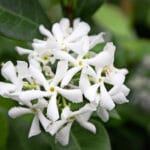
Trachelospermum Jasminoides 20lt Star Jasmine
Original price was: R595.00.R395.00Current price is: R395.00.Add to cartTrachelospermum Jasminoides 20lt
Common Names: Star JasmineFull Sun
Semi Shade
Wind Tolerant
Low Watering
EvergreenA woody vine creeper that grows up to 10m in height with very fragrant clusters of star-shaped, white flowers in Summer. Useful as a ground cover or hedge and for topiaries.
Trachelospermum jasminoides, commonly known as Star Jasmine, is a popular and highly fragrant evergreen vine. It belongs to the Apocynaceae family and is native to China and other parts of East Asia. Trachelospermum jasminoides is widely grown as an ornamental plant for its beautiful, aromatic flowers and its ability to climb walls, trellises, and fences.
Growth Habit: Confederate Jasmine is a climbing vine that can reach heights of 3 to 6m or more. It climbs by twining its stems around support structures, making it a popular choice for covering walls, arbours, and fences.
Leaves: The leaves of Trachelospermum jasminoides are dark green, glossy, and lance-shaped or ovate in form. They are arranged opposite each other along the stems.
Flowers: One of the main attractions of Confederate Jasmine is its highly fragrant, star-shaped white flowers. The flowers are small, typically around 2.5cm in diameter, and they appear in clusters. The intense, sweet fragrance of the blossoms is reminiscent of true jasmine flowers, hence the common name “Star Jasmine.”
Flowering Season: Confederate Jasmine usually blooms in late spring to early summer, but in some regions, it may produce sporadic flowers throughout the year under favourable conditions.
Growth Requirements: Trachelospermum jasminoides thrives in full sun to partial shade and prefers well-draining, fertile soil. Once established, it is relatively drought-tolerant and low-maintenance, making it a popular choice for gardeners.
Uses: Confederate Jasmine is a versatile plant commonly used as a decorative vine in gardens, landscapes, and outdoor spaces. Its fragrant flowers and attractive foliage make it a favourite for covering walls, pergolas, trellises, and fences. It can also be grown in containers for patios and balconies.
